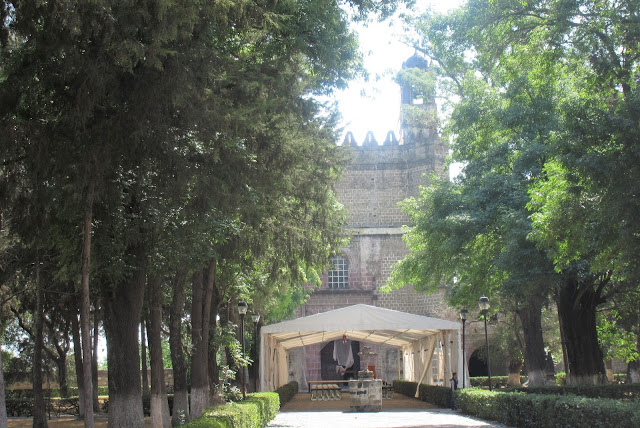March 18, 2018
After our three days in the Villahermosa area, we flew back to Mexico City and took an Uber back to the Maria Cristina Hotel, the same place we had stayed in before going on our side trip, arriving after midnight.
Arnold Pedroza picked us up the following morning for a trip south.
Our first stop was the city of Heujotzingo, population about 60,000 and best known for the Franciscan monastery San Miguel Arcangel, founded in 1525. San Miguel Arcangel, whom we know as the Archangel Michael, is the patron saint of the city and vicinity. This building, finished in 1570, was the third one built on this site and is one of the fourteen monasteries around the base of the volcano Popocatepetl that together have been declared a UNESCO World Heritage Site.
You can see the monasteries marked on the map below. Heujotzingo/San Miguel Arcangel is in the top right quadrant.
The monastery is almost 450 years old--that is a long time for a brick structure to survive in earthquake country. One article I read about the monastery complex noted that it was in great shape and had never been severely damaged by any of the frequent earthquakes in the area. I'm guessing that either that article has not been updated since the 7.1 earthquake that hit just south of Huejotzingo in 2017, or the author of the article didn't consider the damage done by the earthquake to be very significant.
We did notice there was scaffolding holding up the main entrance.
Certainly the walls of the main church that anchors the monastery were still standing, and there didn't seem to be danger of the building collapsing, but it was closed to tourists and worshipers alike when we visited, with a large tent spanning the walkway serving as the temporary chapel.
This beautifully carved sandstone cross with a base of a crown of thorns stands at the entrance to the temporary sanctuary, denoting a sacred space.
We were allowed to peek inside the simple church. It looked like they were mostly doing cosmetic touch ups. Perhaps it did not suffer any major damage after all, of maybe any major repairs were already done.

The altarpiece with its stacked layers reminded me of an Eastern Orthdox iconostasis.

Detail of two of the layers:
The drawing of the church on the left was hanging somewhere in the monastery and dates back to the origins of the complex. The photo on the right shows the church today.


During the colonial era, the church and its accompanying monastic buildings were considered to be the most beautiful buildings in the New World. Like the California missions, the monastery has a central courtyard ringed by cloisters, or covered walkways.
Clearly, some maintenance work has been done since this photo was taken many years ago.
The monastery is famous for its black-and-white murals dating back to the monastery's origin. They are located in a room called the sala de profundis, which is where the monks "practice exercises of meditation and penitence."
This one shows the Virgin Mary in a pose very similar to that of the Virgin of Guadalupe, and critics of the origin story of the Virgin of Guadalupe take this as proof that the image on the peasant's cloak is not of divine origin.
My favorite mural is of Christ washing the feet of his disciples:
This mural shows the first twelve Franciscans to arrive in Mexico
A little bit of Moorish influence can be seem in the peaked doorway:
The washbasin was used by the priests. Isn't the pottery beautiful?
This is the refectory, a room used for communal meals:
This must be the kitchen. Imagine preparing meals for a monastery of monks in this space. Note the black pot suspended in what used to be the cooking fire on the right.
The bedrooms included a comfy wooden slab for a bed.
There are a lot of interesting art and architectural embellishments throughout. My notes say this is Peter and Paul on the left, but I'm not sure about that. I have NO IDEA who that is on the right--some priest who is literally on a pedestal.
The Virgin of Guadalupe is in every Catholic church in Mexico.
Interesting niches in the cloister walk are in various states of deterioration, but sometimes it is refreshing to see something that has NOT been restored and actually looks as old as it is.
We had read about the monasteries surrounding the volcanos before we left on our trip, and they are listed in our 501 Must-Visit Destinations book, which we regularly consult before traveling abroad. I really liked this monastery and felt that it lived up to the hype.





































Definitely off the regular tourist trail in this town.
ReplyDeleteI think this was my favorite church in Mexico. I loved it. I love the depiction of the new world apostles, the 12 Franciscan friars.
ReplyDelete